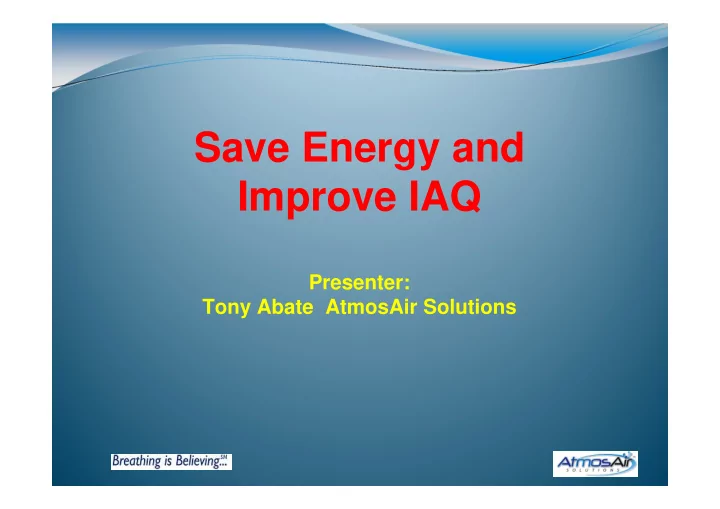

Save Energy and Improve IAQ Presenter: Tony Abate AtmosAir Solutions
Where Does Energy Go? � Commercial Buildings in the US consume 18% of total energy usage � 40% of that energy is used by the HVAC systems � HVAC energy usage stems from the need to condition outside air for comfort. To heat, cool and dehumidify the air to maintain a comfortable indoor environment 2
Outside Air Ventilation � In order to maximize energy efficiency, building envelopes are being built tighter than ever and sealed tighter to allow less air leakage in. � This can degrade indoor air quality (IAQ) by buildup of gaseous contaminants, particles and microbials. � To address this, ASHRAE has established ventilation codes (Standard 62.1) which require mechanical outside ventilation be introduced to maintain acceptable air quality. � The problem is, outside air uses energy and costs money! 3
Reducing Outside Air Ventilation • ASHRAE Standard 62.1 in addition to prescriptive values for outside air, also allows for an engineered approach called the IAQ Procedure. • The IAQ Procedure allows reductions to the prescriptive values for outside air as long as typical air contaminants are identified and an air cleaning strategy is implemented to achieve removal of those contaminants. The IMC and NYS mechanical codes also allow for reductions • to outside air using this engineered approach. • Bi-Polar Air Ionization is a very effective air cleaning strategy to control contaminants and minimize energy use. 4
Bi-Polar Ionization Technology • Bi-Polar Ion systems impart energy to building supply air to form positive and negative air ions. • Bi-Polar Ions are a naturally occurring element. Waterfalls, crashing surf, lightning, etc will create bi-polar ions. Ions interact with contaminants • and reduce their levels like particles, spores, VOC’s and gasses and bacteria and molds. 5
Bi-Polar Ionization Benefits • Affects a Broad Range of Contaminants - Particles, VOC’s Gasses and Microbials are reduced. Low Energy Use • - A typical system consumes only 40 watts of power. • Cost Effective in IAQ Procedure Design - Systems do not restrict airflow, do not require mechanical or airflow re-design by their use. Energy savings are maximized. • Tested Performance - 3 rd party laboratory and project validation testing has shown stated performance of these systems.
Bi-Polar Ionization Performance Particle Reduction Natural 12.8% Bi-Polar Ionization 85.8% Natural 67.1% Bi-Polar Ionization 91.1% Testing Performed to ANSI / AHAM AC -1-2002 Protocol Dust CADR 125 Mold CADR 190 MERV 13 Equivalent 7
Bi-Polar Ionization Performance TVOC Reduction 8
IAQ Procedure Case Study Florida Power & Light Administrative office building in Plantation FL, 25,000 ft2 • occupancy 125. • Outside air reduced 10 cfm per person per ASHRAE 62.1 IAQ procedure. Bi-Polar ionization used as air cleaning strategy. • IAQ measurements taken pre and post reductions. • Reductions in particle levels of 49% and TVOC of 31% were measured using the IAQ procedure design. 1 st year electricity savings of 72,248 KWH realized with • reduced outside air. 4 ton HVAC capacity reduction potential. • 9
IAQ Procedure Case Study US Army Administrative building in VA, 8,000 ft2 occupancy 50. • • Outside air reduced per ASHRAE 62.1 IAQ procedure incrementally over a 4 week period from 30 cfm per person to 5 cfm. Bi-Polar ionization used as air cleaning strategy. • IAQ measurements taken baseline and weekly. • HVAC power logging taken continually over the 4 week period. • Reductions in particle levels of 70% and TVOC of 30% were measured using the IAQ procedure design. Power logging data showed a 23% reduction in HVAC power • demand from baseline to week 4. 10
Summary • Outside air introduction in buildings consumes a major portion of energy used in the US. • Reducing outside air in buildings can achieve significant energy savings. • ASHRAE, IMC and NYS all recognize an engineered design approach where outside air can be reduced if IAQ is maintained by an effective air cleaning strategy. • Bi-Polar Ionization as an air cleaning strategy in an engineered design has achieved energy savings and improved IAQ.
Thank You! Contact Info: Tony Abate tabate@atmosair.com www.atmosair.com 12
Recommend
More recommend